When we first reviewed the LSI WarpDrive in March of last year, we absolutely loved its performance in the then-emerging PCIe SSD storage solution space. Much has changed since the initial review: StorageReview has updated our enterprise testing platform and enterprise SSD testing methodology and EMC has qualified the WarpDrive in their server caching solution, VFCache. LSI continues to improve the platform by purchasing SandForce, the controllers used in the WarpDrive solution, to bring more technology in-house.
By purchasing SandForce, LSI greatly expands their presence in the SSD space. Already a supplier of core silicon components throughout the storage space at large, there's a tremendous difference between owning your own SSD controller technology and buying someone else's. With LSI now owning such a key components of their PCIe SSD solution, we'd fully expect future versions, like WarpDrive 2, to feature a more cohesive build, with even better performance, reliability and compatibility. The acquisition also gives LSI an edge in terms of support for the current WarpDrive product, with easier and more rapid access to firmware updates that can progressively improve the product over time. With the long lifespan solutions like this find in the enterprise space, superior firmware is a substantial advantage.
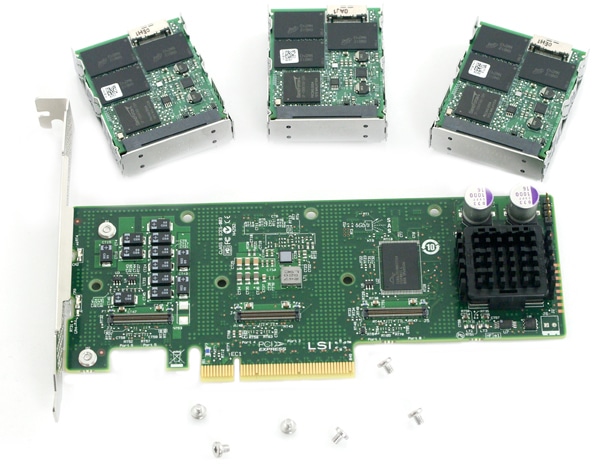
The LSI WarpDrive SLP-300 is built around 384GB of Micron SLC NAND combined with six SandForce SF-1500 processors. With 300GB of available space, working out to roughly 22% of over-provisioning, the WarpDrive advertises sustained sequential write speeds of up to 1,400MB/s and random large-block transfers of up to 1,200MB/s. In the random 4K space it is able to provide 150,000 IOPS read and 190,000 IOPS write.
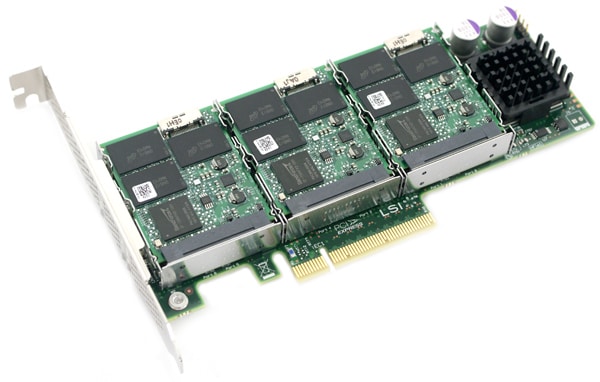
LSI WarpDrive SLP-300 Specifications
- 300GB storage (384GB of Micron 3xnm SLC NAND)
- PCI Express 2.0 8x host interface
- ECC protection up to 24 bits per 512 bytes
- LSI SAS2008 Controller
- Simpler integration using SAS infrastructure
- Enterprise reliability
- 4 KB reads: Up to 150K Random, Up to 240K Sequential
- 4 KB writes: Up to 190K Random, Up to 200K Sequential
- Average latency of less than 50 microseconds
- Powered entirely by the PCIe slot, consumes <25 Watts
- Supports Windows and Linux operating systems
- Three year warranty
Synthetic Benchmarks
Given the higher performance capabilities of a PCIe SSD like the LSI WarpDrive, we slightly modified our standard testing methods beyond how we stress-test single enterprise SATA/SAS SSDs. To fully saturate the card we had to increase the I/O load through multiple managers and workers in IOMeter, otherwise we would not see the full potential of this drive. Our method allowed us to still work with the drive in an unformatted setup with two managers and two workers interfaced with the same 5GB LBA segment. This allowed us to fully saturate the LSI WarpDrive and reach the burst speeds that the drive is advertised to support.
We split the synthetic IOMeter testing portion of this review into two parts. The first is our standard low queue-depth tests, which are performed at a QD=1 level on single drives and on PCI-e SSDs at a level of QD=4 given the manager/worker thread count. The initial tests are more in line with single-user environments, whereas higher queue depth ranges in the second half are more like what the card would see in a server with I/O requests stacked up.
To see how well it performed in straight-line performance we used IOMeter with a 4K-aligned sequential 2MB transfer test, with an effective queue depth rate of 4.
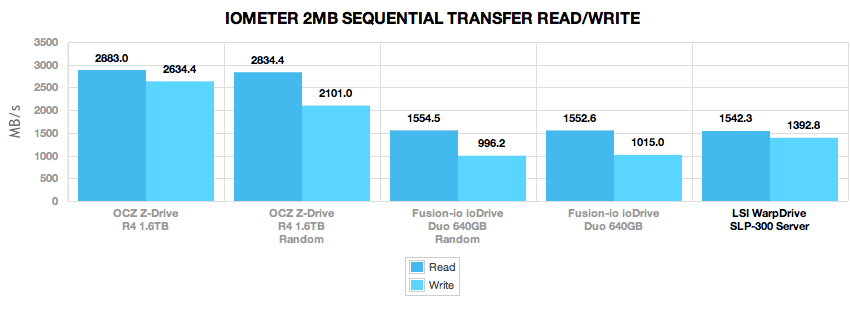
The WarpDrive showed strong performance, measuring 1,542MB/s read and 1,392MB/s read.
Our next test looks at random large-block transfers, but still keeping the 2MB transfer size.
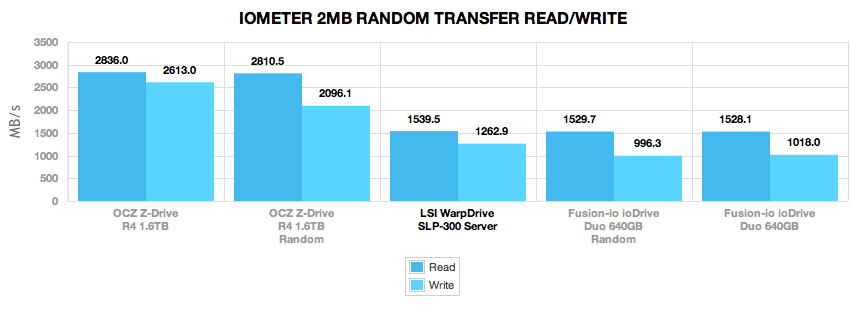
In the 2MB random transfer test the read speeds stayed at roughly the same level, measuring 1,539MB/s, but the write speeds dropped to 1,262MB/s.
Our next test looks at both low queue-depth 4K random read/write as well as peak queue-depth figures for all of the PCI-e SSDs we have tested in our lab.
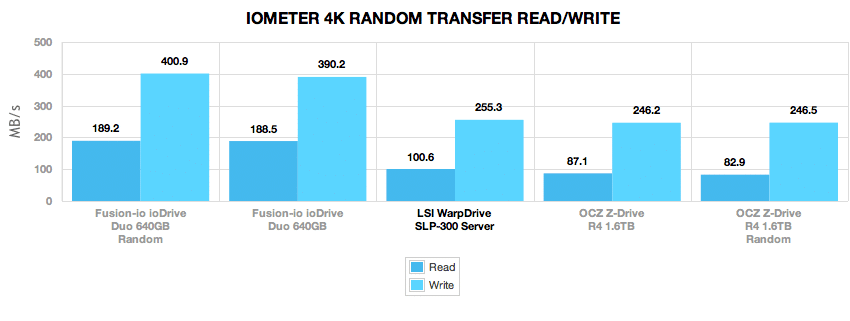
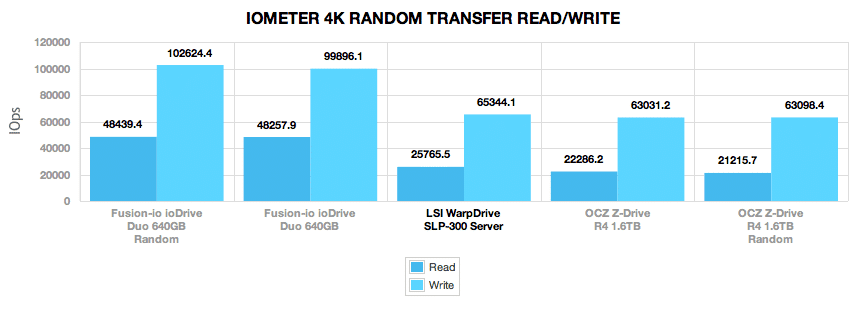
At a low effective queue depth of 4, the LSI WarpDrive measured 25,765 IOPS read and 65,344 IOPS write, offering strong performance off the line. In this scenario the Fusion-io ioDrive did outpace it though.
Given the slightly weaker QD=4 performance of the WarpDrive, it wasn't a surprise to see higher latency figures than the Fusion-io ioDrive in our chart. The differences in peak latency can probably be chalked up to NAND and controller differences, especially with the WarpDrive having six SandForce processors to sync together compared to just two controllers on the ioDrive Duo. Max latency was excellent, topping out at 27.7ms over the duration of our test.
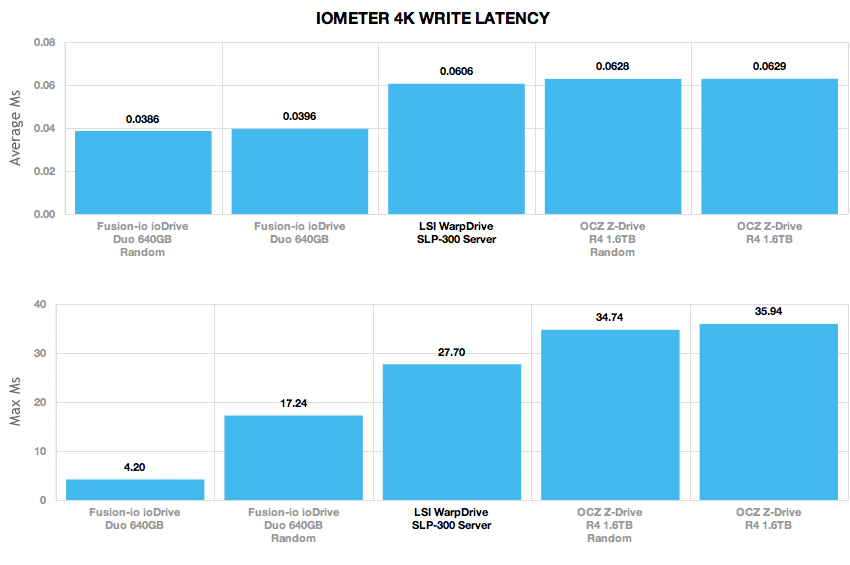
The next half of our synthetic benchmarks are ramped tests, covering performance from early queue depth levels to either a max of 64 (QD=256) or 128 (QD=512). This section also includes our server profile tests, which from the start are designed to show how well enterprise products perform under demanding mixed server loads.
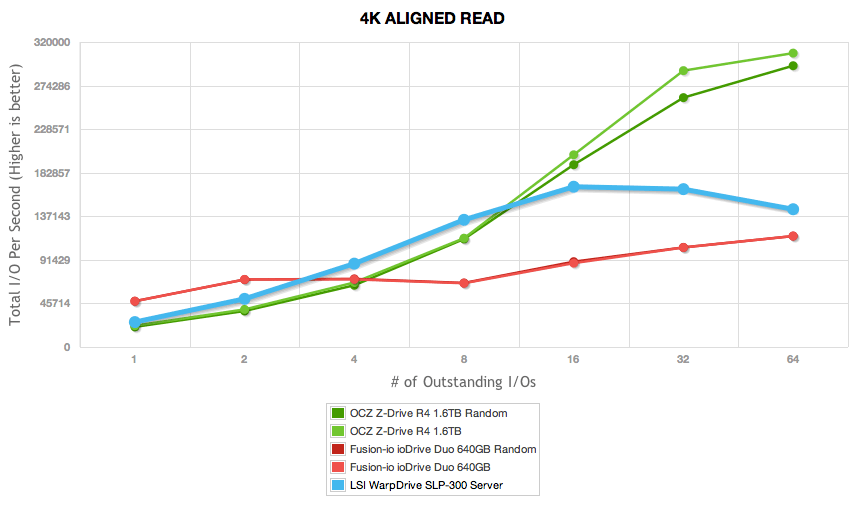
The WarpDrive quickly reaches its peak performance levels, showing a strong rise at queue depth 8 and above.
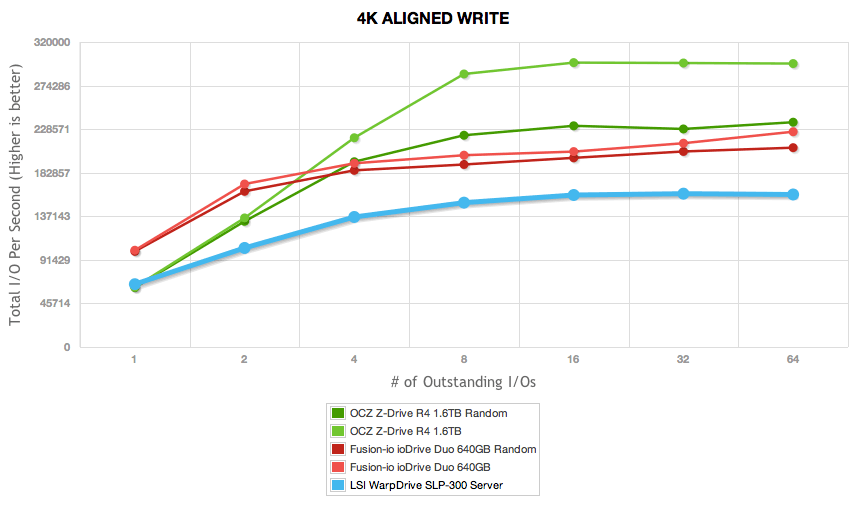
In our ramped 4K write test, the WarpDrive topped at 160,000 IOPS with repeating data.
The next half of our synthetic benchmarks are also ramped tests, covering performance from early queue depth levels to either a max of 64 (QD=256) or 128 (QD=512). This section includes our server profile tests, which from the start are designed to show how well enterprise products perform under demanding mixed server loads. The LSI WarpDrive maintained very strong performance, only being outpaced by the OCZ Z-Drive R4 which has eight total controller from the latest SandForce generation.
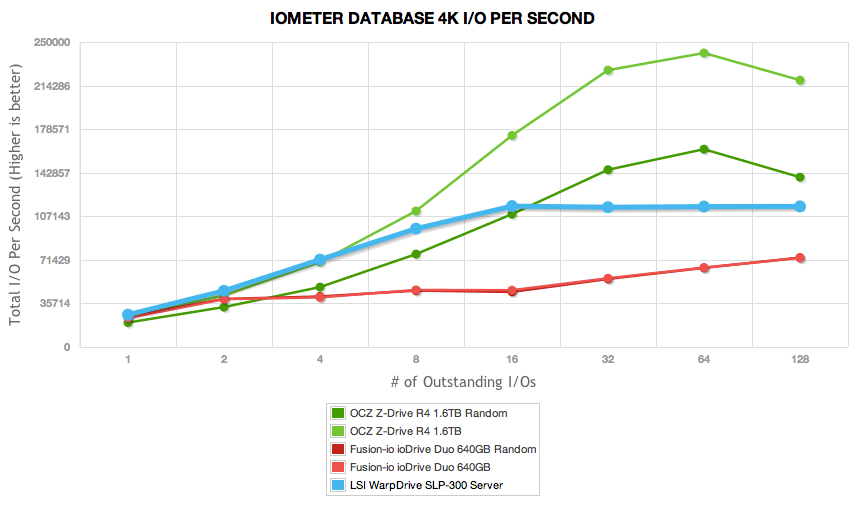
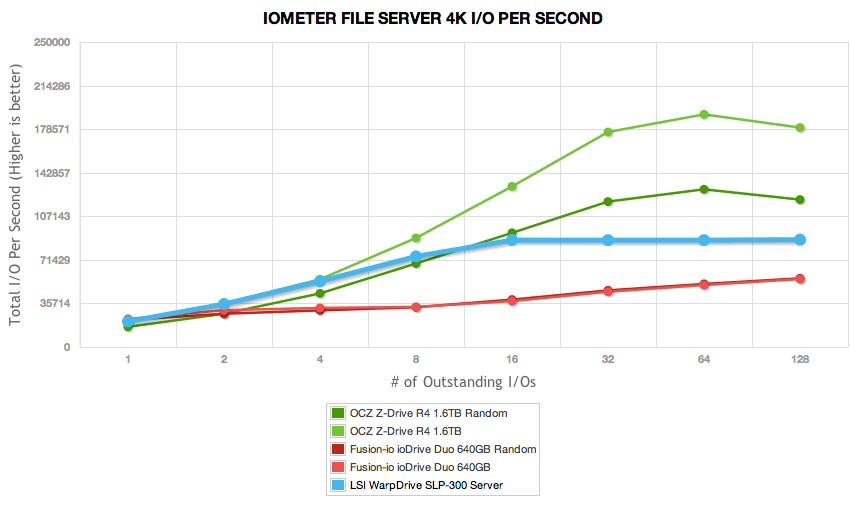
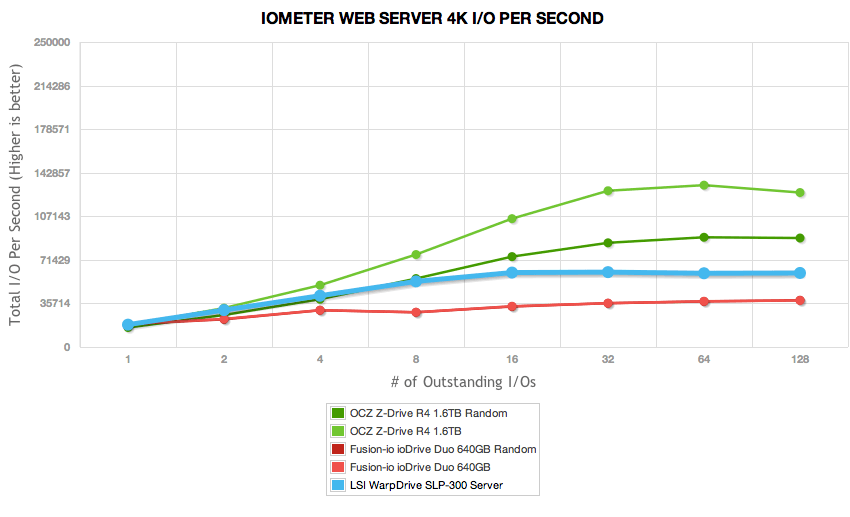
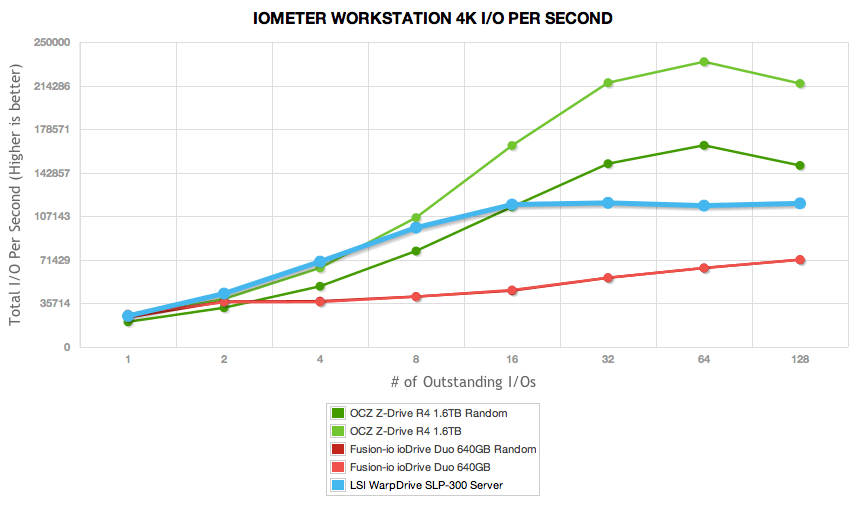
Enterprise Synthetic Benchmarks
Flash performance changes the longer you write to a drive and speeds taper down until the drive hits its steady state speed. In an enterprise setting, initial burst is hardly relevant if after one hour of use the drive won't see that speed again. This is where steady state benchmarking comes in, showing how the drive performs when under a 24/7 load. For this reason, all of the following benchmarks were pre-conditioned and recorded in a steady-state mode.
We used our StorageReview Enterprise Testing Environment to benchmark the LSI WarpDrive; accurately representing its capabilities in an enterprise environment. The enterprise testing platform is based around a Lenovo ThinkServer RD240, equipped with dual Intel Xeon X5650 processors, running Windows Server 2008 R2. All IOMeter figures are represented as binary figures for MB/s speeds.
Our first test looks at the speed in a sequential write environment with large block transfers. This particular test uses a 2MB transfer size with IOMeter, with 4k sector alignment and measures performance with a queue depth of 4.
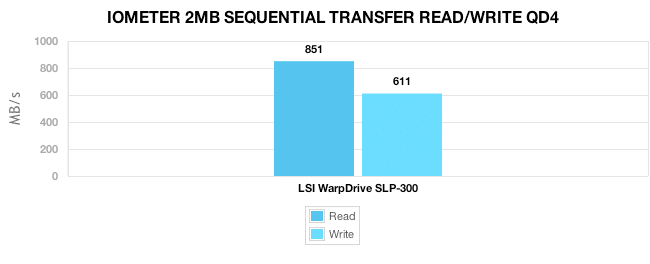
With fully incompressible data the LSI WarpDrive maintained a strong read speed of 851MB/s and a write speed of 611MB/s.
Moving to a random access profile, but still maintaining a large block transfer size of 2MB, we start to see how performance varies in a multi-user environment. This test keeps the same queue depth level of 4 that we used in the prior sequential transfer benchmark.
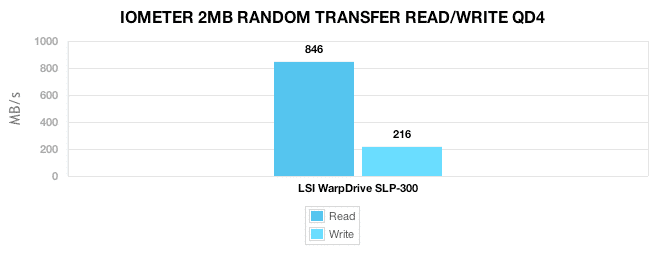
Incompressible steady read speeds were unphased by switching to a random transfer, measuring 846MB/s. Write speeds dropped, however when compared to some of the single 2.5-inch enterprise SSDs we have reviewed recently, the WarpDrive offers 2-3x the speed measuring 216MB/s.
Our next test looks at 4K random write performance at a static queue depth of 32 and results are recorded and averaged once the drives have reached steady-state. While IOPS performance is a good metric to measure steady-state performance, another key area of interest is around average and peak latency. Higher peak latency figures can mean certain requests can backed up under heavy continuous access.
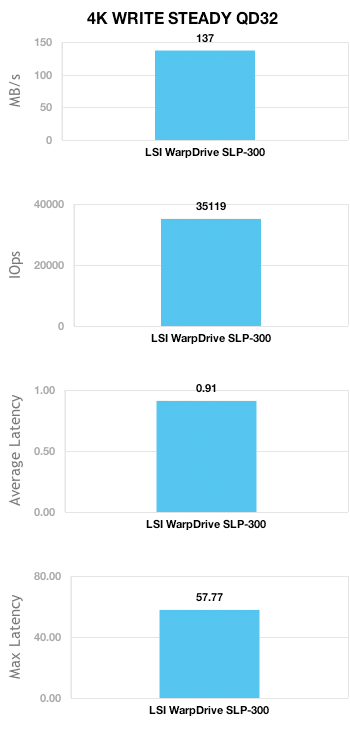
In steady-state with fully incompressible data, the WarpDrive settled in at a random 4K write speed of 35,119 IOPS with an average latency of 0.91ms at a queue depth of 32. Max latency over the duration of this test measured 57.77ms, with no high peaks.
Each of our server profile tests has a strong preference towards read activity, ranging from 67% read with our database profile to 100% read in our web server profile. Since the WarpDrive utilizes SandForce processors that can compress data for faster speeds, we measured steady-state performance with 0% and 90% compressibility. This shows the two polar sides of real-world conditions where some data in a given environment can be repeating and compressed.
Our first sever profile covers database conditions, with a 67% read and 33% write workload mix primarily centered on 8K transfer sizes.
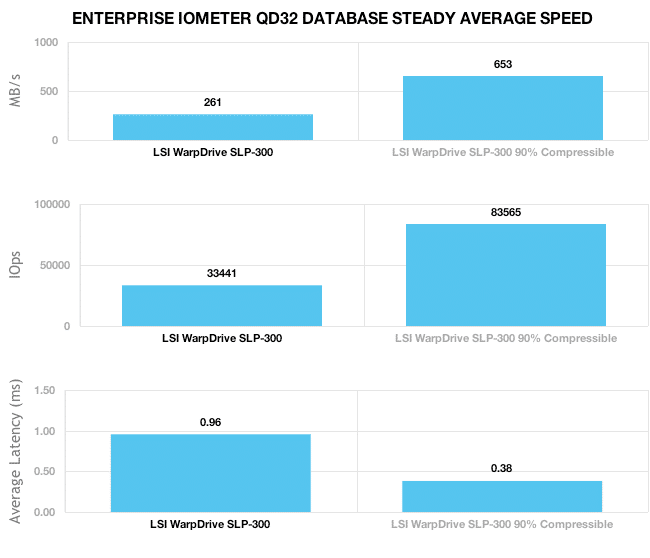
In our database profile the WarpDrive was capable of pushing 33,441 IOPS with incompressible data, which sped up to 83,565 IOPS with 90% compressible information.
The next profile looks at a file server, with 80% read and 20% write workload spread out over multiple transfer sizes ranging from 512-byte to 64KB.
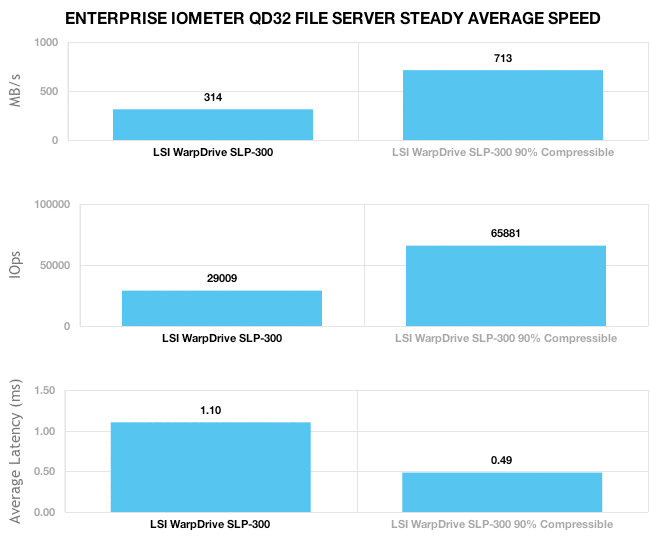
In our file server test the WarpDrive still offered inpressive speeds with fully incompressible data, measuring 29,009 IOPS, speeding up to over 65,000 IOPS with a 90% compressible pattern.
Our web server profile is read-only with a spread of transfer sizes from 512-byte to 512KB.
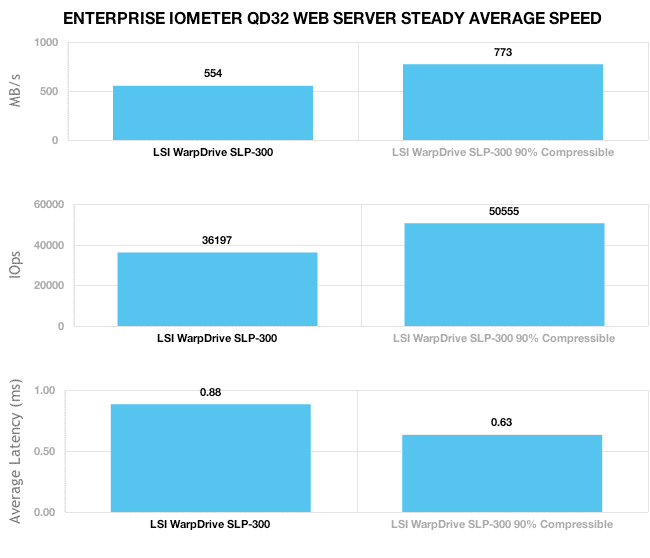
It was surprising to see a difference in speed between compressibility levels in our webserver profile being read-only. In this test the WarpDrive measured 36,197 IOPS with incompressible data and 50,555 IOPS when 90% compressible.
The last profile looks at a workstation, with a 20% write and 80% read mixture using 8K transfers.
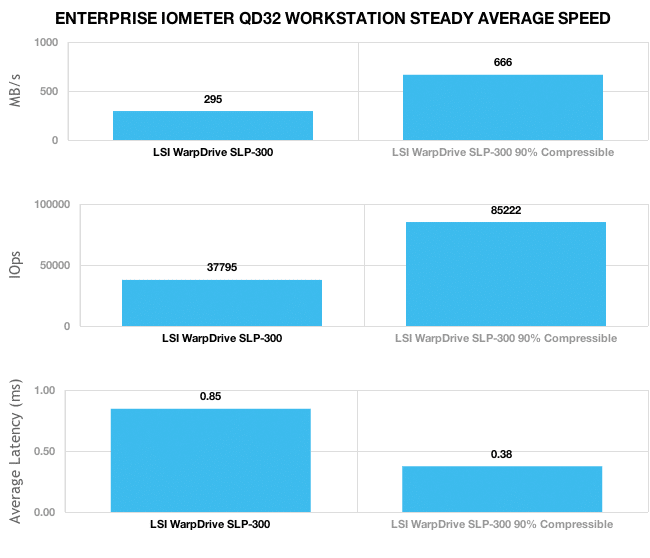
In a workstation setting the LSI WarpDrive had speeds measuring 37,795 IOPS with incompressible data that scaled up to 85,222 IOPS with 90% compressible information.
Real-World Benchmarks
Our enterprise trace covers a Microsoft Exchange mail-server environment. We captured the activity of our StorageReview mail server over a period of a few days. This server hardware consists of a Dell PowerEdge 2970 running Windows Server 2003 R2 environment operating off of three 73GB 10k SAS hard drives in RAID5 on the Dell Perc 5/I integrated controller. The trace consists of many small transfer requests, with a strong 95% read load with 5% write traffic.
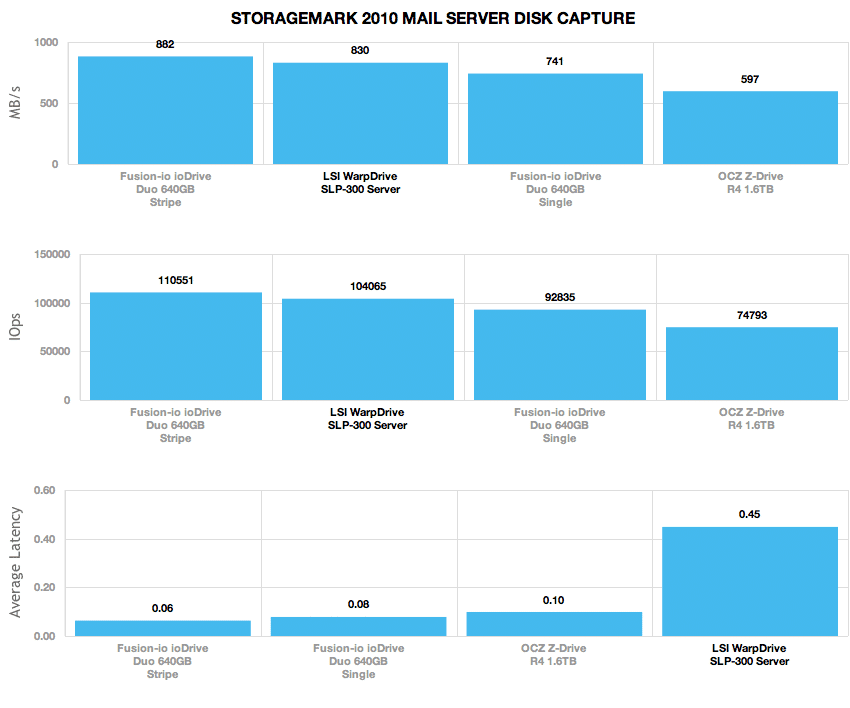
In an enterprise-trace setting covering a mail server, the LSI WarpDrive maintained speeds of 830MB/s pushing over 104,000 IOPS.
Conclusion
We were glad to be able to re-review the LSI WarpDrive SLP-300 in the new enterprise testing environment. While the PCIe SSD space continues to be fluid, one thing is clear, solutions with quality components and engineering are going to find their way to the top of this rapidly growing market. That's part of what is so exciting about the WarpDrive – with LSI now owning the key controller technology, the current and future WarpDrive products should continue to be quite impressive, giving LSI an engineering lead when it comes to PCIe SSDs based on SandForce technology.
While clearly not the fastest PCIe storage solution we've seen, it is one that by far has the strongest driver support. Based around the LSI SAS2008 controller, this card is compatible with most major operating systems, including Windows, Linux, and Mac OS. It is also bootable, which not all PCIe SSD solutions are. Packing wide-range compatiblity with strong I/O performance in endurance situations, the LSI WarpDrive has what enterprise buyers want. Leveraging six SandForce SF-1500 controllers, we saw random 4K write speeds in a worst-case scenarios with incompressible data measure 35,000 IOPS in steady-state. In areas where the data might not be entirely random like our Database environment, the SandForce processors were able to speed transactions up, boosting performance from the mid 30k IOPS range to above 80K IOPS.
The SLP-300 WarpDrive isn't for everyone though. With this model being SLC-only it's probably overkill for some situations where there isn't constant write activity, where eMLC solutions might be more cost effective with enough endurance to get the job done. It woudn't be terribly surprising to see LSI offer an eMLC-based solution at some point though.
LSI changed the game by buying SandForce. With a key engineering advantage, LSI can not only better support the current generation WarpDrive, but they'll have a significant head start when using SandForce processors in the next generation WarpDrive 2. With the length of time these products spend in production environments, support is a big deal and while at times hard to quantify, there's a clear benefit in having an engineering team and processor in-house, especially when coupled with LSI's longstanding pedigree in storage.
Pros
- Bootable with excellent compatibility
- Lives up to its name with great performance, without requiring external power
- SandForce processors handily boost performance in areas with some compressibility
- Small size, not much larger than the footprint of a standard RAID card
Cons
- Only available in 300GB capacity
- No eMLC option
Bottom Line
The LSI WarpDrive SLP-300 is first and foremost a high-performance enterprise PCIe SSD that excels in the market it is intended for. Combining the compatibility and reliability of the LSI SAS2008 controller with six SandForce SF-1500 processors and 300GB of usable SLC NAND, LSI created a potent device that can deliver superb performance in high I/O usage scenarios with some compressiblity. Even though several other options have hit the market since it was first released, the WarpDrive still holds it own in this rapidly expanding market.




 Amazon
Amazon